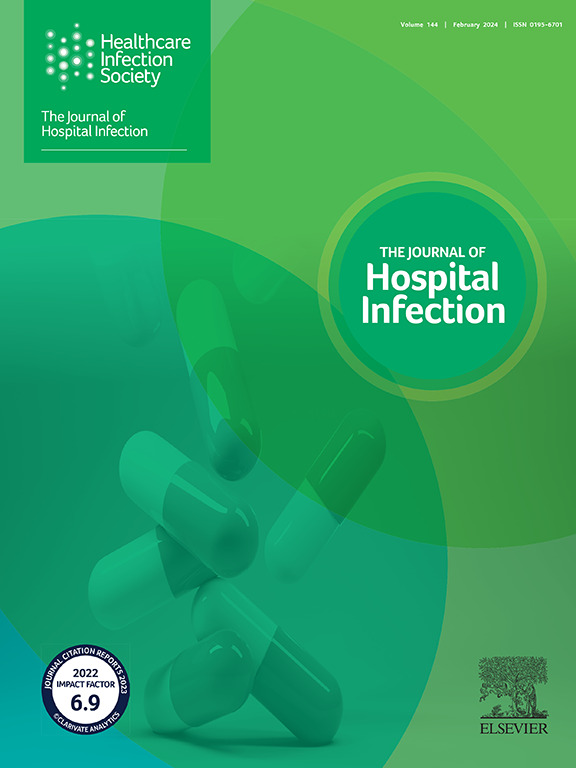瑞士一家三级医院中心导管相关血流感染监测指标的变化趋势。
IF 3.9
3区 医学
Q1 INFECTIOUS DISEASES
引用次数: 0
摘要
背景:中心静脉相关性血流感染(CLABSI)与相关的发病率和死亡率有关。CLABSI发病率和致病微生物谱的纵向动态变化十分有限:我们旨在描述 CLABSI 发病率、中心静脉置管的使用和致病病原体的变化趋势:我们分析了一家瑞士三级医院在 2016 年 1 月至 2023 年 12 月期间前瞻性收集的 CLABSI 数据。我们调查了发病密度、导管使用和致病病原体的纵向变化:结果:共观察到 707 例 CLABSI,发病密度为每 1000 个导管日 1.69(95% CI 1.56 - 1.81)例 CLABSI。每1000导管日CLABSI发病密度无明显趋势(z=0.86,P=0.391),但导管使用率有所上升(z=8.88,PConclusions:前瞻性 CLABSI 监测表明,每 1000 个导管日的发病密度保持稳定,但致病微生物随时间发生了显著变化。本文章由计算机程序翻译,如有差异,请以英文原文为准。
Trends in surveillance indicators for central-catheter-associated bloodstream infections in a tertiary hospital in Switzerland
Background
Central line-associated bloodstream infections (CLABSIs) are associated with relevant morbidity and mortality. Longitudinal dynamics in CLABSI incidence and the spectrum of causative microorganisms are limited.
Aim
To describe trends in CLABSI incidence, use of central lines, and causative pathogens.
Methods
We analysed prospectively collected data on CLABSI at a Swiss tertiary care hospital between January 2016 and December 2023. We investigated longitudinal changes of incidence densities, catheter utilization and causative pathogens.
Findings
A total of 707 CLABSIs were observed, corresponding to an incidence density of 1.69 (95% confidence interval 1.56–1.81) CLABSIs per 1000 catheter-days. There was no significant trend of CLABSI incidence density per 1000 catheter-days (z = 0.86, P=0.391), but an increase of catheter utilization ratio (z = 8.88, P<0.001). Coagulase-negative staphylococci (N = 207, 23.4%) and Enterococcus spp. (N = 134, 15.2%; E. faecium N = 94, 10.6%; E. faecalis N = 37, 4.1%; other Enterococcus spp. N = 3, 0.34%) were the most frequent causative pathogens. Over the years, the proportion of Enterococcus spp. (z = 3.4, P<0.001), driven by an increase of E. faecium (z = 3.2, P=0.001), and yeast (z = 2.3, P=0.020) increased, whereas coagulase-negative staphylococci decreased (z = -6.1, P<0.001).
Conclusions
Prospective CLABSI surveillance indicated stable incidence densities per 1000 catheter-days, but there were significant shifts of causative microorganisms over time.
求助全文
通过发布文献求助,成功后即可免费获取论文全文。
去求助
来源期刊

Journal of Hospital Infection
医学-传染病学
CiteScore
12.70
自引率
5.80%
发文量
271
审稿时长
19 days
期刊介绍:
The Journal of Hospital Infection is the editorially independent scientific publication of the Healthcare Infection Society. The aim of the Journal is to publish high quality research and information relating to infection prevention and control that is relevant to an international audience.
The Journal welcomes submissions that relate to all aspects of infection prevention and control in healthcare settings. This includes submissions that:
provide new insight into the epidemiology, surveillance, or prevention and control of healthcare-associated infections and antimicrobial resistance in healthcare settings;
provide new insight into cleaning, disinfection and decontamination;
provide new insight into the design of healthcare premises;
describe novel aspects of outbreaks of infection;
throw light on techniques for effective antimicrobial stewardship;
describe novel techniques (laboratory-based or point of care) for the detection of infection or antimicrobial resistance in the healthcare setting, particularly if these can be used to facilitate infection prevention and control;
improve understanding of the motivations of safe healthcare behaviour, or describe techniques for achieving behavioural and cultural change;
improve understanding of the use of IT systems in infection surveillance and prevention and control.
 求助内容:
求助内容: 应助结果提醒方式:
应助结果提醒方式:


